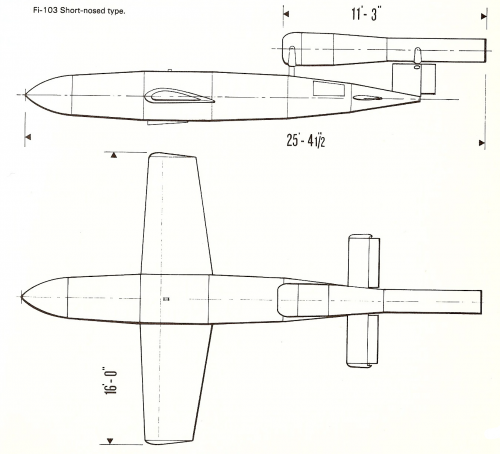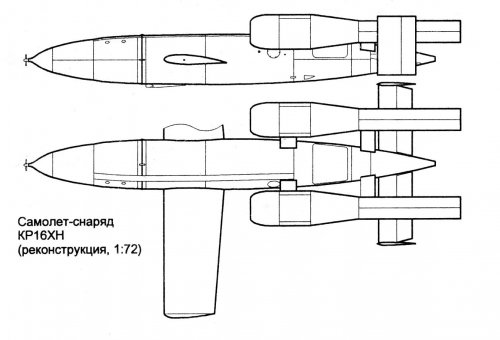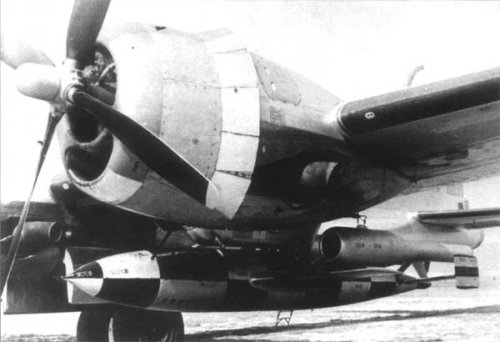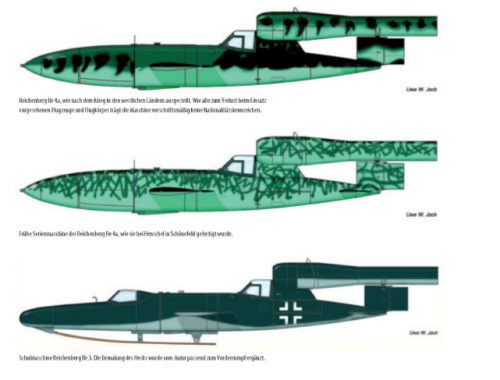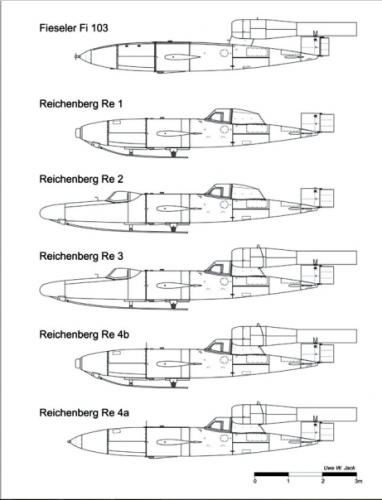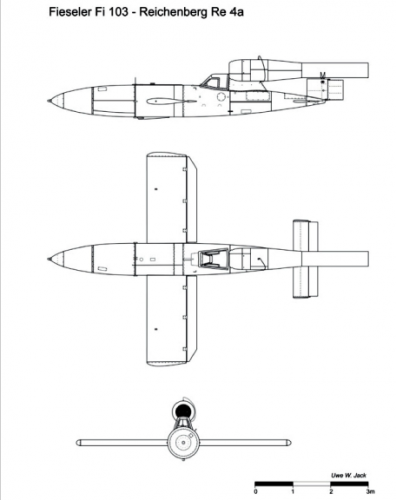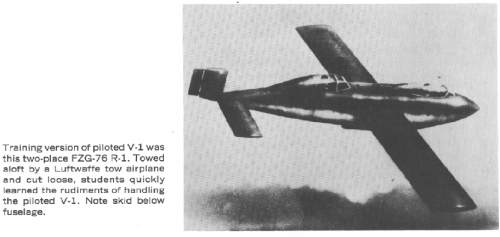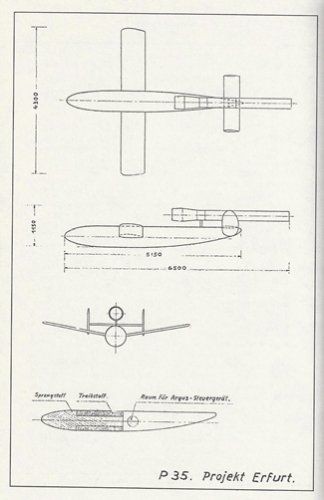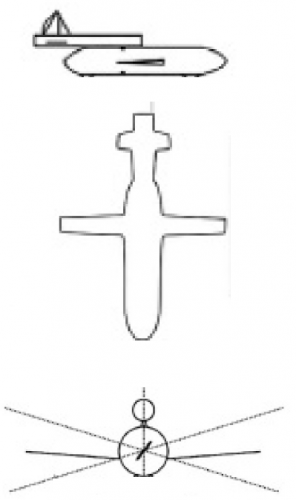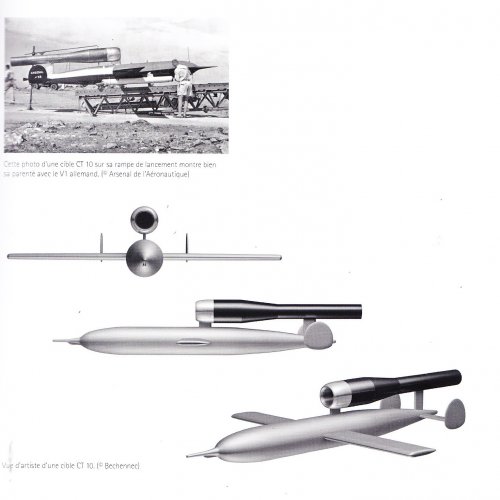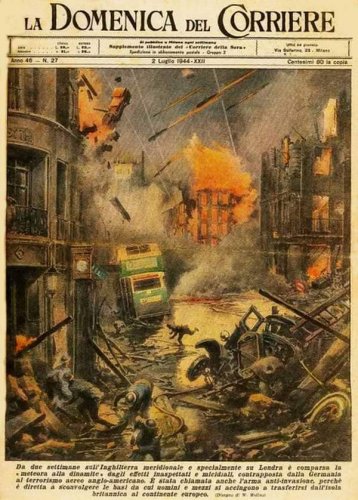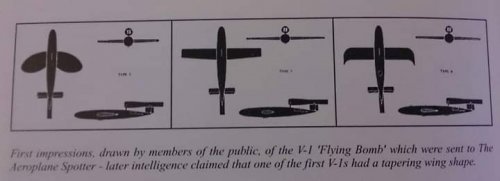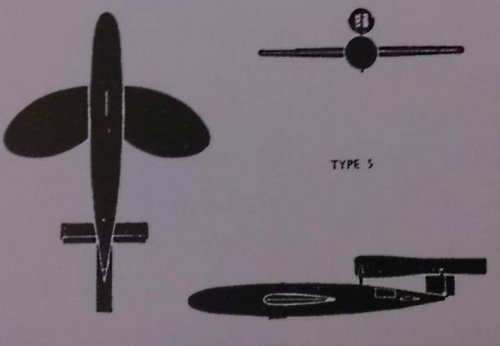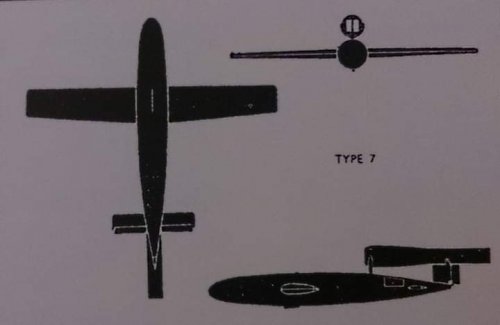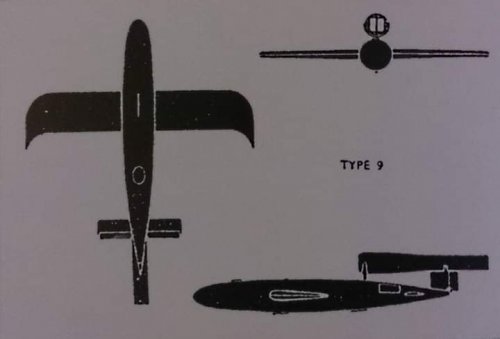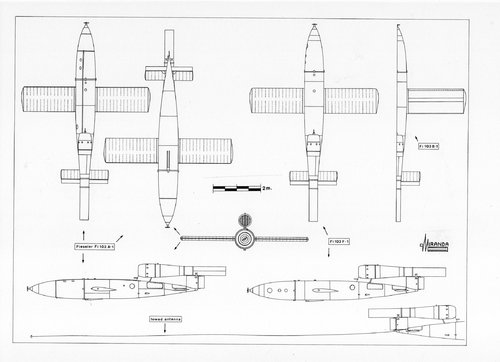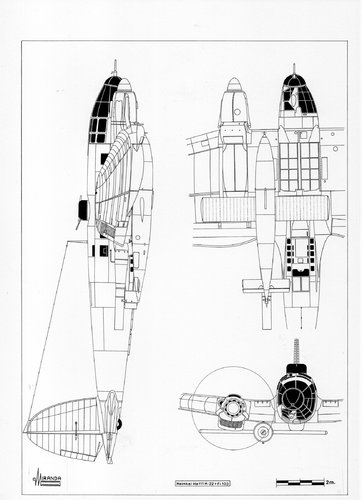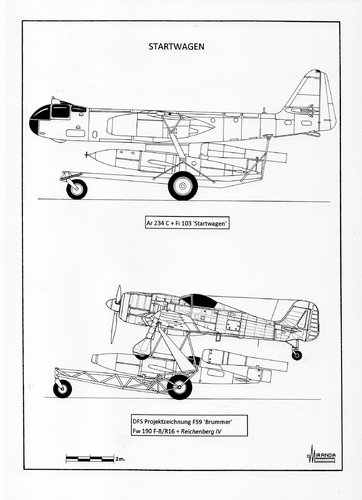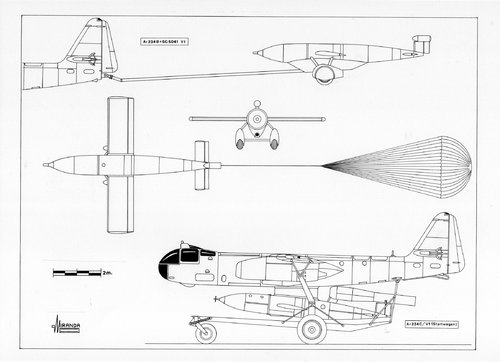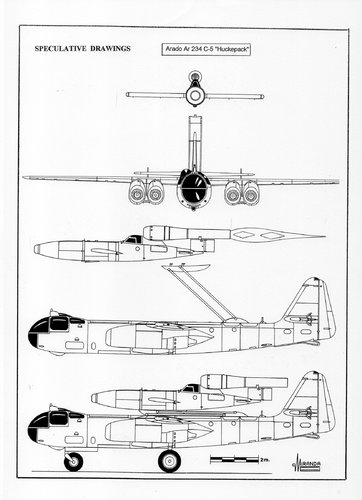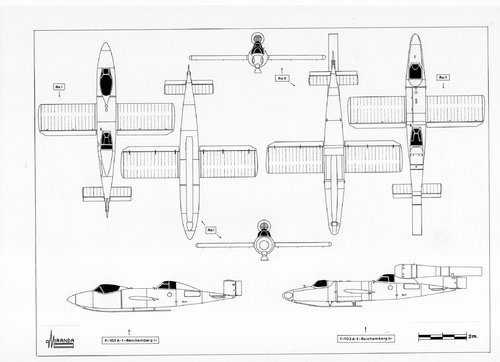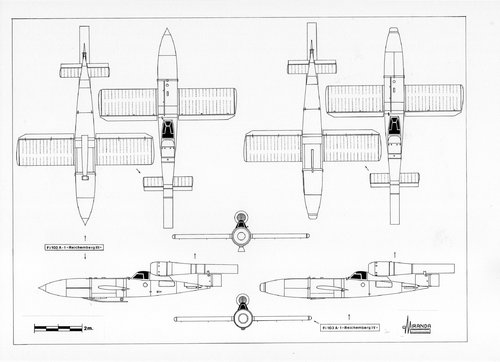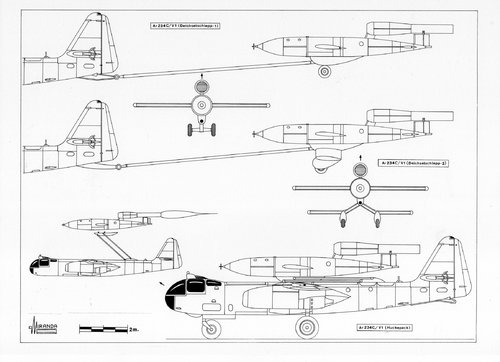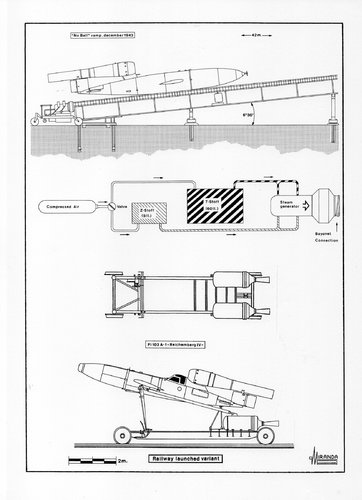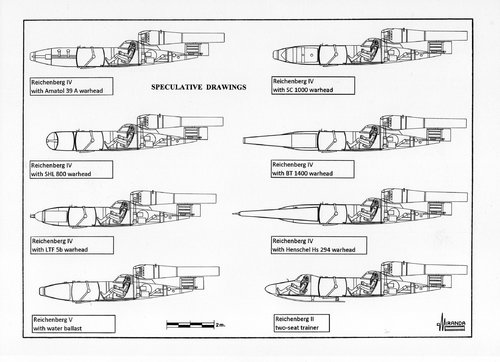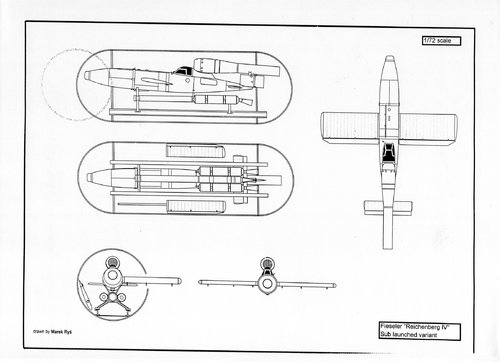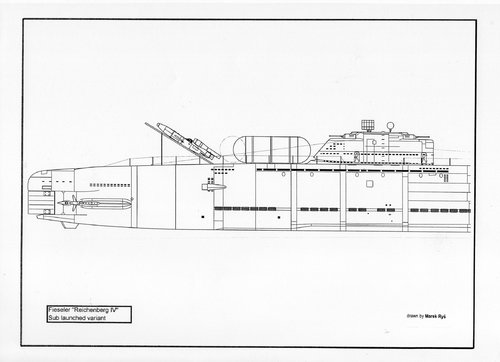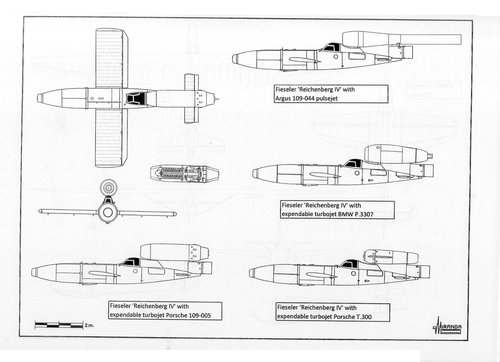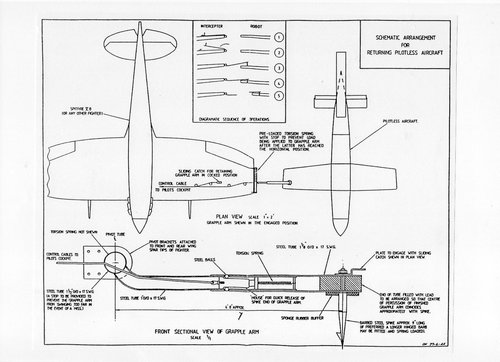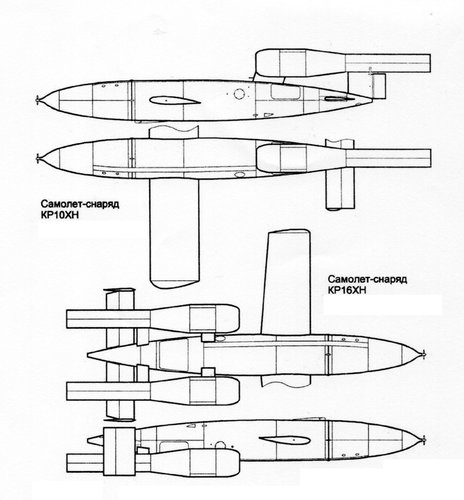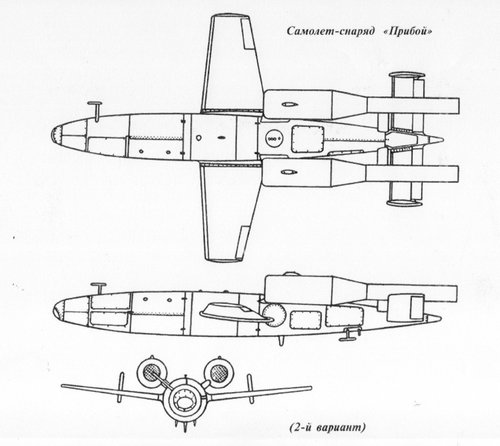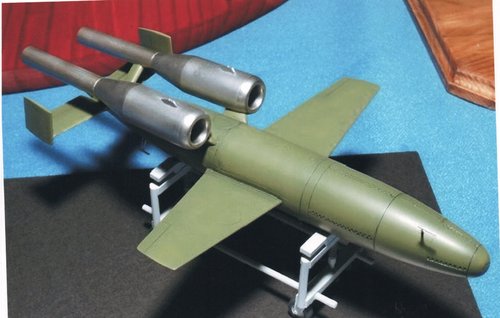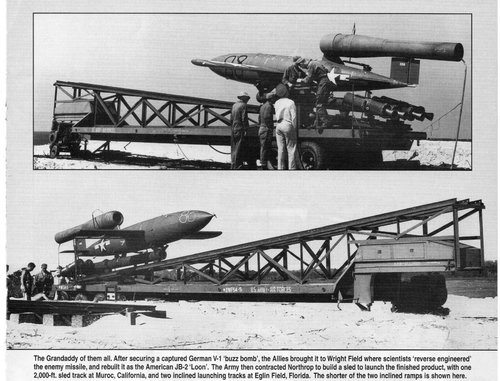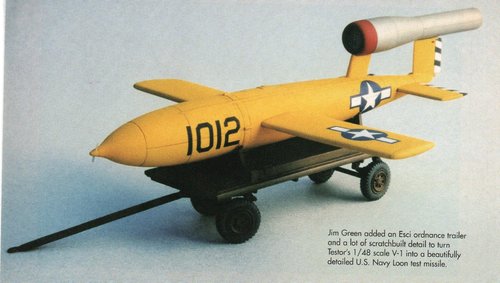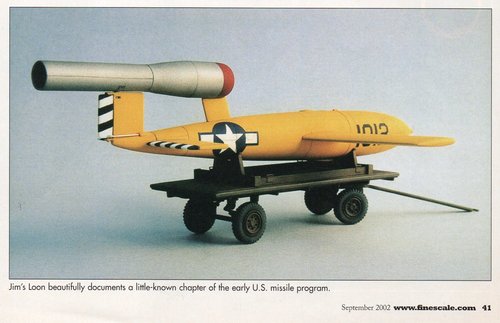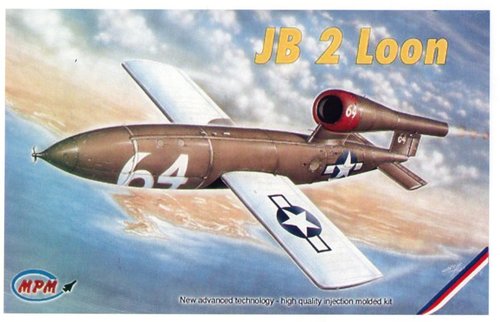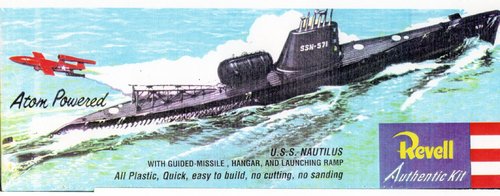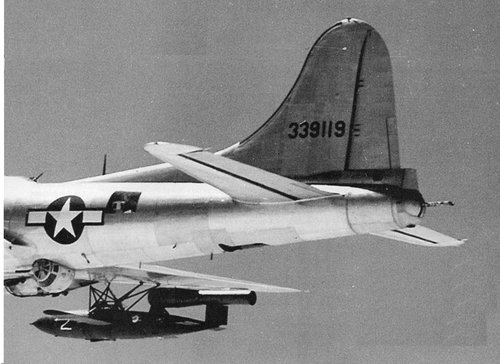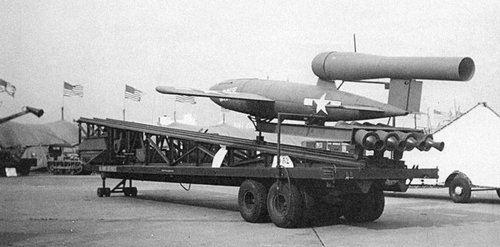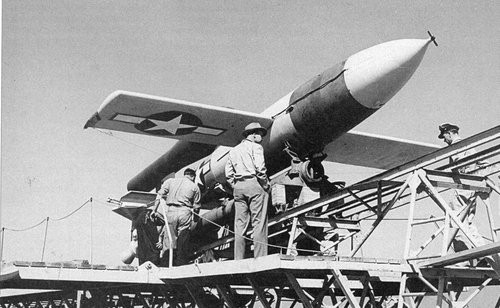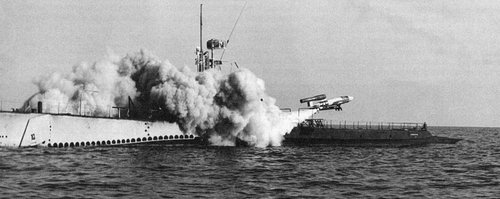You are using an out of date browser. It may not display this or other websites correctly.
You should upgrade or use an alternative browser.
You should upgrade or use an alternative browser.
Fieseler Fi-103 (V 1) development, variants and derivatives
- Thread starter RyanC
- Start date
Wasp
ACCESS: Restricted
- Joined
- 11 January 2010
- Messages
- 28
- Reaction score
- 12
I find the wings of the russian version interesting. Is this possibly a copy of those tapered shaped V-1 wings?
As for the increased pressure by detonation, I'm not sure if that would have been easily applyable to the Argus Pulsejets, as they already had a hard time to limit the vibrations of those with lower pressure, experiencing distortions of the pulsejets exhaust.
As for the increased pressure by detonation, I'm not sure if that would have been easily applyable to the Argus Pulsejets, as they already had a hard time to limit the vibrations of those with lower pressure, experiencing distortions of the pulsejets exhaust.
- Joined
- 13 August 2007
- Messages
- 8,177
- Reaction score
- 10,034
this twin-pulsejet is NOT A Fi-103 derivative
This is derivative on Junkers EF 60 and EF 126 Elly and EF 127 Walli Objektschutzjäger
had to used Argus-Schmidt pulsejet, (original one)
note in russia twin-pulsejet picture, the wing configuration is a Low wing and form is like Junkers EF 60 126 127

http://www.luft46.com/junkers/juef126.html
source:
Die Deutsche Luftfahrt
Hugo Junkers Pionier der Luftfahrt - seine Flugzeug
By Wolfgang Wagner
Bernard & Graete Verlag
This is derivative on Junkers EF 60 and EF 126 Elly and EF 127 Walli Objektschutzjäger
had to used Argus-Schmidt pulsejet, (original one)
note in russia twin-pulsejet picture, the wing configuration is a Low wing and form is like Junkers EF 60 126 127

http://www.luft46.com/junkers/juef126.html
source:
Die Deutsche Luftfahrt
Hugo Junkers Pionier der Luftfahrt - seine Flugzeug
By Wolfgang Wagner
Bernard & Graete Verlag
- Joined
- 1 May 2007
- Messages
- 2,571
- Reaction score
- 1,873
I once saw a drawing and if I remember correctly the "Shortnose" was not only shorter, but had differntly shaped wings than the standard version.
Is this correct?
From 'The Flying Bomb', Richard Anthony Young, page 135.
The author states that the short-nose version "...appear to have been survivors of a pre-production batch."
cheers,
Robin.
Attachments
Wasp
ACCESS: Restricted
- Joined
- 11 January 2010
- Messages
- 28
- Reaction score
- 12
Michel Van said:this twin-pulsejet is NOT A Fi-103 derivative
This is derivative on Junkers EF 60 and EF 126 Elly and EF 127 Walli Objektschutzjäger
had to used Argus-Schmidt pulsejet, (original one)
note in russia twin-pulsejet picture, the wing configuration is a Low wing and form is like Junkers EF 60 126 127
Do you have any data that confirms the direct connection between these Junkers projects and the russian Twin-Pulsejet?
I really don't think that it was based on the EF60/126/127 Junkers project.
For one the russian wing looks far more like the tapered V-1 wing clearly showing in the drawing that Robin provided, than the wing of far great span of the EF 126 model.
Also the conclusion, that the EF 126 etc. was a low wing design, therefore the russian missile did develop from that is in my opinion very thin as well, because the finally build EF 126 from 1946 under soviet control was a midwing and early design drawings shows it as a midwing too.
It was common practice of course to test differend wing designs on the windtunnel models, which probably led to the model seen in the picture.
Changing the V-1s midwing design to a low wing simply makes sense from an aerodynamically point of view, because of the use of two engines. Becaus those engines now sit not directly abvoe the fuselage but angeled to the side, they also were closer in the line of the original midwing, which probably could have caused a worse airflow to the intakes due to the airflow around the wings especially the turbulence in angeled positions (during the start i.e.). So lowering the wings could have been an easy solution to avert this problem.
robunos said:From 'The Flying Bomb', Richard Anthony Young, page 135.
The author states that the short-nose version "...appear to have been survivors of a pre-production batch."
Yes, I think this is it.
Thank you!
The author could have been very well correct with his statement, as the simple front attachement of the engine on a "pole" was indeed used on the prototypes.
Attachments
- Joined
- 7 June 2009
- Messages
- 531
- Reaction score
- 151
Michel Van said:this twin-pulsejet is NOT A Fi-103 derivative
This is derivative on Junkers EF 60 and EF 126 Elly and EF 127 Walli Objektschutzjäger
had to used Argus-Schmidt pulsejet, (original one)
note in russia twin-pulsejet picture, the wing configuration is a Low wing and form is like Junkers EF 60
No, you are mistaken.
Of course EF-126 was actually developed and even tested under Soviet control and even in the USSR itself. But the model on rickshaw's photo has no connection to it. The model actually represents 16Kh Priboy (16Х "Прибой" (Breaking wave)), a flying bomb designed by Vladimir Chelomey in 1947 and tested since 1948 to 1953. It was actually a V-1 derivative - the last evolution stage, after 1945-built 10Kh (Soviet copy of the V-1) and more advanced (but still single-engine) 14Kh from 1946.
The 16Kh wasn't low-wing, it was middle-wing like all its precursors. It's just the bad aspect angle of the photo.
Technical data:
Wing span - 4.68 m
Length - 7.6 m
Fuselage diameter - 0.84 m
Wing area - 4.91 m2
Weight - 2557 kg
Warhead weight - 950 kg
Powerplant - two D-14-4 pulsejets, 2.5 kN each
Maximum speed - around 900 km/h
Operational range - 190 km
Cruising altitude - 1000 m
The attached drawing is from Belarusian Aeroplan magazine, issue 12 (year 1995). I also attach a photo of 16Kh test missile under the Tu-4: you see, it is mid-wing. More info in Russian here: http://www.airwar.ru/weapon/ab/priboy.html.
Returning to EF-126 - any flying bombs or missiles weren't developed on its base, it was tested only as piloted attack aircraft.
Attachments
- Joined
- 13 August 2007
- Messages
- 8,177
- Reaction score
- 10,034
the soviets show great interest in Junkers design and move the project to USSR after WW2Do you have any data that confirms the direct connection between these Junkers projects and the russian Twin-Pulsejet?
but abandoned the project after testpilot was kilt as EF 60 glider crashed.
Some of EF 126 design was later reused on advance version of russian V1 called 10Kh
(EF 126 has middel wing, not like EF 60 low wing)
- Joined
- 7 June 2009
- Messages
- 531
- Reaction score
- 151
Michel Van said:Some of EF 126 design was later reused on advance version of russian V1 called 10Kh
(EF 126 has middel wing, not like EF 60 low wing)
???... It's hardly possible, because the 10Kh came up before the EF-126!
The EF-126 made its first flight in Germany on May 21, 1946; in the Soviet Union - on March 16, 1947. The 10Kh missile was tested since March 20, 1945...
- Joined
- 26 January 2011
- Messages
- 2,230
- Reaction score
- 616
Michel Van said:this twin-pulsejet is NOT A Fi-103 derivative
I didn't claim it was. I'm not sure why you assumed I had made that claim? The point I was making was that, despite what was claimed, some people seemed to think having two pulsejets on their missile seemed to confer some advantage, thats all. Perhaps they knew something?
- Joined
- 26 May 2006
- Messages
- 34,266
- Reaction score
- 14,869
Hi,
I read this article about the Fieseler V-1,and I found this Project P 35 Erfurt,
and I am asking,what is that P series,and did it belong to Argus,Lorentz AG
or Fieseler ?.
http://en.wikipedia.org/wiki/V-1_(flying_bomb)
I read this article about the Fieseler V-1,and I found this Project P 35 Erfurt,
and I am asking,what is that P series,and did it belong to Argus,Lorentz AG
or Fieseler ?.
http://en.wikipedia.org/wiki/V-1_(flying_bomb)
- Joined
- 13 August 2007
- Messages
- 8,177
- Reaction score
- 10,034
Project 35 "Erfurt" was a Argus & Fieseler join venture for flying Bomb study,
on 27 February 1942 it was a Aircraft with 2 Pulsengine under wing,
April 1942 it became the V1 design with one Pulse engine
with range of 300 km with speed of 700 km/h and 500 kg warhead
and had to be radar or radio controlled, but the RLM consider useless because ECM by the Allies
so design change to gyrocompass control Autopilot
on 19 June 1942 the project was approved and term P35 was change to Fi-103
http://books.google.be/books?id=kGyc0NZEe_QC&pg=PT7&lpg=PT7&dq=Project+P+35+Erfurt&source=bl&ots=NggSAyGv9H&sig=4nKvglHw2pgtShnhotlHSFYxqHE&hl=en&ei=HddnTaH7IY2whQfH3YHzDg&sa=X&oi=book_result&ct=result&resnum=3&ved=0CCsQ6AEwAg#v=onepage&q&f=false
on 27 February 1942 it was a Aircraft with 2 Pulsengine under wing,
April 1942 it became the V1 design with one Pulse engine
with range of 300 km with speed of 700 km/h and 500 kg warhead
and had to be radar or radio controlled, but the RLM consider useless because ECM by the Allies
so design change to gyrocompass control Autopilot
on 19 June 1942 the project was approved and term P35 was change to Fi-103
http://books.google.be/books?id=kGyc0NZEe_QC&pg=PT7&lpg=PT7&dq=Project+P+35+Erfurt&source=bl&ots=NggSAyGv9H&sig=4nKvglHw2pgtShnhotlHSFYxqHE&hl=en&ei=HddnTaH7IY2whQfH3YHzDg&sa=X&oi=book_result&ct=result&resnum=3&ved=0CCsQ6AEwAg#v=onepage&q&f=false
- Joined
- 9 October 2009
- Messages
- 21,330
- Reaction score
- 12,544
There is an interesting declassified report (Google docs link) from April 1945 that I just discovered while looking for more info on Myrol.
Among other things, there is a reference which indicates that Allied intelligence suspected that the Germans had been experimenting with a (60% Hydrogen Peroxide) D2R solution in the launching of V-1s (the catapult steam generator normally used a T-Stoff/Z-Stoff reaction). The report notes this in the context that Myrol had being looked at by the Geramans as a Hydrogen Peroxide replacement in a wide range of applications, including as a rocket fuel/ rocket fuel component. This was due in part to major shortfalls in the production of Hydrogen Peroxide despite the best efforts of the RLA (Armament Supply Office).
The report also noted that since the main processing plant was now in the hands of the advancing Russians, not much more could be expected out of German Myrol related efforts despite it's promise as a rocket fuel. That plant, which used a production process involving the continous vapor-phase nitration of methanol, had been located at Christianstadt on the Boder.
So it looks like Myrol may have been looked at for more than just an alternate warhead filler, with regards as to the V-1 program.
Among other things, there is a reference which indicates that Allied intelligence suspected that the Germans had been experimenting with a (60% Hydrogen Peroxide) D2R solution in the launching of V-1s (the catapult steam generator normally used a T-Stoff/Z-Stoff reaction). The report notes this in the context that Myrol had being looked at by the Geramans as a Hydrogen Peroxide replacement in a wide range of applications, including as a rocket fuel/ rocket fuel component. This was due in part to major shortfalls in the production of Hydrogen Peroxide despite the best efforts of the RLA (Armament Supply Office).
The report also noted that since the main processing plant was now in the hands of the advancing Russians, not much more could be expected out of German Myrol related efforts despite it's promise as a rocket fuel. That plant, which used a production process involving the continous vapor-phase nitration of methanol, had been located at Christianstadt on the Boder.
So it looks like Myrol may have been looked at for more than just an alternate warhead filler, with regards as to the V-1 program.
- Joined
- 13 August 2007
- Messages
- 8,177
- Reaction score
- 10,034
the Myrol option would work for the Mittelwerk V1 Production site
because they have Potash salt deposit to make nitric acid in Mittelwerk GBMH factory
also in south and east of Mittelwerk are rich Lignite deposit, ideal for Methanol production
Nitric acid and Methanol makes Myrol
although, i have doubt that some thing unstable like Myrol can be used in V1 catapult or rocketfuel to replace T-stoff
but the Wehrmacht was totally distressed in those days...
because they have Potash salt deposit to make nitric acid in Mittelwerk GBMH factory
also in south and east of Mittelwerk are rich Lignite deposit, ideal for Methanol production
Nitric acid and Methanol makes Myrol
although, i have doubt that some thing unstable like Myrol can be used in V1 catapult or rocketfuel to replace T-stoff
but the Wehrmacht was totally distressed in those days...
Grey Havoc said:There is an interesting declassified report (Google docs link)
Also available as a PDF here:http://www.dtic.mil/dtic/tr/fulltext/u2/122495.pdf
- Joined
- 9 October 2009
- Messages
- 21,330
- Reaction score
- 12,544
A June 1948 Project Squid report regarding the the V-1's pulsejet:
The Aero-Resonator Power Plant of the V-1 Flying Bomb
The Aero-Resonator Power Plant of the V-1 Flying Bomb
A detailed study is presented of the development of the pulsejet engine which served as
the power plant for the German V-1 flying bomb. The history and development of the
pulsejet from its crudest designs and the test stands developed for this type engine are
considered. The dissertation on resonator valves covers inlet valves, flow valves, and
controlled valves. The general basic requirements, origins of resonator shapes, and
special resonator tube shapes are discussed as well as the basic requirements and basic
types of mixture formation, mixture formation equipment for vaporous and gaseous fuels
and powder fuels, and special arrangements of the spoiler nozzle mixture formation
process. The principles of automatic mixture regulation and gas mixture arrangements
are reviewed.
- Joined
- 26 May 2006
- Messages
- 34,266
- Reaction score
- 14,869
hesham said:here is the Fieseler P.35 Erfurt,which led to V-1.
V-1 Flying bomb 1942-52
Hi,
as I read before,the manned version of V-1 (Fi.103R) was given anther "P"
designation number,but where,can anyone help ?.
lippischh
ACCESS: Secret
- Joined
- 22 January 2006
- Messages
- 4,178
- Reaction score
- 1,880
Just found this interesting three-view of the P 35 Erfurt on this link
The article looks interesting. Which idiom is it? I can't identify and I'd like to use Google Translator...
Thanks in advance,
Antonio
martinbayer
ACCESS: Top Secret
- Joined
- 6 January 2009
- Messages
- 3,120
- Reaction score
- 3,328
pometablava said:Just found this interesting three-view of the P 35 Erfurt on this link
The article looks interesting. Which idiom is it? I can't identify and I'd like to use Google Translator...
Thanks in advance,
Antonio
Dutch
I suggest the book The V1 and its Soviet Successors by Wilfried Kopenhagen. ISBN 0-7643-1274-X
It even shows a French version, NORD CT-10.
https://www.amazon.com/Soviet-Successors-Schiffer-Military-History/dp/076431274X
It even shows a French version, NORD CT-10.
https://www.amazon.com/Soviet-Successors-Schiffer-Military-History/dp/076431274X
Dilandu
I'm dissatisfied, which means, I exist.
Well, there was the "Ansaldo" Fi-106, adapted for shipborne use Fi-103 reconstruction (made on basis of Bornholm crash intelligence data).
Based on Aircraft Carrier Impero: The Axis Powers’ V-1 Carrying Capital Ship - Davide F. Jabes, Stefano Sappino (Fonthill, 2018)
Based on Aircraft Carrier Impero: The Axis Powers’ V-1 Carrying Capital Ship - Davide F. Jabes, Stefano Sappino (Fonthill, 2018)
Attachments
Retrofit
ACCESS: Top Secret
- Joined
- 21 February 2007
- Messages
- 655
- Reaction score
- 326
edwest said:It even shows a French version, NORD CT-10.
The Arsenal 5501, later officialy referenced as CT 10 was, grosso modo, a half-scaled V1 designed as an aerial target.
413 built including 50 for the Royal Navy.
First flight: December the 17th, 1949.
Photo & drawings from "Missiles Tactiques Européens" Patrick Mercillon, Ed. ETAI 2017
Attachments
Log into Facebook
Log into Facebook to start sharing and connecting with your friends, family, and people you know.
 www.facebook.com
www.facebook.com
Attachments
Last edited:
To try to answer some questions in the forum: There were at least 3 types of Fi 103:s tested in Peenemünde. The first of them was called V-zellen (Versuchszellen) and they had this pole under the Argusrohr. They had a V before the number painted on the fuselage - V83 or V183 was painted on the one which came down on Bornholm in august 1943. The 2nd was the M-zellen (Musterzellen) and the 3rd was the G-zellen (Großseriezellen). The wings of the M-zellen was attached more forward than on the G-zellen and that makes the nose look shorter. They also had cylindrical air tanks of a type also used in the Reichenbergs to make room for the pilot. The most of the fuselage of the M (150) 208 is preserved in Sweden since the end of November 1943 when it was found ashore outside Utlängan.
Can I direct folks attention to the drawings, which are clearly contradictory, even to the extent of designations.
I recently bought a 1/35 Reichenburg powered two seat trainer (a Bronco kit) this seems to be based on the Flieger Revue drawings - yet photos show the nose is disproportionately long and thin. In my opinion, Justo has it right,
As for the powered single seat variant, drawings show an impossibly small skid - but are there any photos of the original (or original drawings)
Are there any photos of the single seat training glider ?
The two seat glider is depicted as basically a single seater with similar forward cockpit and standard nose - this seems likely as a one -off but was there really a GLIDER version
of the final powered trainer with its lower forward cockpit ........ are there photos or original drawings of either of these ??? or is it purely guesswork ?
When you consider the practical reality - Reichenburg glider training in late 1944 would have been risky and perhaps impractical. Would they have been air launched by He.111 or aerotowed by a fairly powerful aircraft ?? All very risky with roaming Mustangs and using scarce fuel. The use of the powered two seater seems logically more practical - so I do wonder if the two seat gliders were built but quickly abandoned ? and if more than on was ever built.
For such an infamous type, its is surprising that these details still seem to be unknown. Cn anyone enlighten the darkness ?
Paul
I recently bought a 1/35 Reichenburg powered two seat trainer (a Bronco kit) this seems to be based on the Flieger Revue drawings - yet photos show the nose is disproportionately long and thin. In my opinion, Justo has it right,
As for the powered single seat variant, drawings show an impossibly small skid - but are there any photos of the original (or original drawings)
Are there any photos of the single seat training glider ?
The two seat glider is depicted as basically a single seater with similar forward cockpit and standard nose - this seems likely as a one -off but was there really a GLIDER version
of the final powered trainer with its lower forward cockpit ........ are there photos or original drawings of either of these ??? or is it purely guesswork ?
When you consider the practical reality - Reichenburg glider training in late 1944 would have been risky and perhaps impractical. Would they have been air launched by He.111 or aerotowed by a fairly powerful aircraft ?? All very risky with roaming Mustangs and using scarce fuel. The use of the powered two seater seems logically more practical - so I do wonder if the two seat gliders were built but quickly abandoned ? and if more than on was ever built.
For such an infamous type, its is surprising that these details still seem to be unknown. Cn anyone enlighten the darkness ?
Paul
Dilandu
I'm dissatisfied, which means, I exist.
When you consider the practical reality - Reichenburg glider training in late 1944 would have been risky and perhaps impractical. Would they have been air launched by He.111 or aerotowed by a fairly powerful aircraft ?? All very risky with roaming Mustangs and using scarce fuel.
"Engineer Hans really didnt want to be drafted for Eastern Front, so he insisted that the useless project must be continued" (c) Also, a question of receiving the funding...
- Joined
- 26 May 2006
- Messages
- 34,266
- Reaction score
- 14,869
Well, there was the "Ansaldo" Fi-106, adapted for shipborne use Fi-103 reconstruction (made on basis of Bornholm crash intelligence data).
Hi Dilando,
are you sure from Fi-106 designation,or that was a written mistake ?.
Dilandu
I'm dissatisfied, which means, I exist.
Hi Dilando,
are you sure from Fi-106 designation,or that was a written mistake ?.
It was "Ansaldo" attempt to reconstruct the Fi-103, based on what's data they managed to stole. They suggested, that this missile could be used to arm the Italian Navy warships, and tentatively gave the naval variant of Fi-103 the Fi-106 label. Don't know exactly why 106.
Dilandu, funding comes down from the top, not bcause the engineers wants to avoid the eastern front !
My point is - logic suggests that glider training was probably tried but soon abandoned in favour of the powered two seater.
However what I am really interested in, is hard facts - are there any photos or original drawings of the glider variants ? if not all the drawings are pure guesswork.
Hubert Chances drawing of the two seat glider states it was seen at Peenemunde and his drawing of the colour scheme suggests a photo - but has anyone seen such a photo ?
Paul
My point is - logic suggests that glider training was probably tried but soon abandoned in favour of the powered two seater.
However what I am really interested in, is hard facts - are there any photos or original drawings of the glider variants ? if not all the drawings are pure guesswork.
Hubert Chances drawing of the two seat glider states it was seen at Peenemunde and his drawing of the colour scheme suggests a photo - but has anyone seen such a photo ?
Paul
Some additional info and speculative stuff
Attachments
Similar threads
-
Fi-103 (V-1) missiles on Aircraft Carrier Impero
- Started by Temistocle
- Replies: 1
-
-
-
"Why is there a Bucket on your nose, Mr. DOODLEBUG??"
- Started by xylstra
- Replies: 14
-



